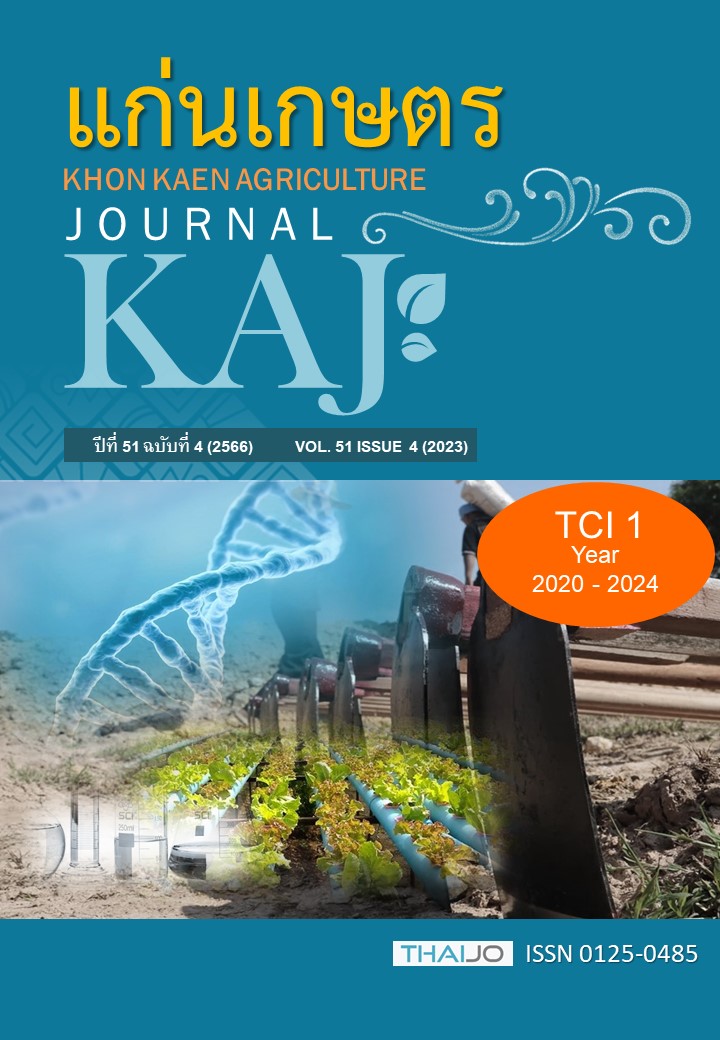ผลของแบคทีเรียเอนโดไฟท์ที่มีศักยภาพการตรึงไนโตรเจนและสังเคราะห์ไอเอเอต่อการเติบโตของต้นอ่อนกล้วยไม้แวนดาในสภาพปลอดเชื้อ
Main Article Content
บทคัดย่อ
การเพาะเลี้ยงเนื้อเยื่อกล้วยไม้ เป็นเทคนิคที่นิยมใช้ในอุตสาหกรรมการผลิตกล้วยไม้ ซึ่งการเพาะเลี้ยงเนื้อเยื่อมักเติมสารควบคุมการเจริญเติบโต เช่น สารกลุ่มออกซิน จิบเบอเรลลิน เป็นต้น ดังนั้นการศึกษานี้จึงนำแบคทีเรียเอนโดไฟท์ 3 ไอโซเลท ที่แยกได้จากแวนดาสายพันธุ์มนุวดีที่สามารถตรึงไนโตรเจนและผลิตสารออกซินได้ มาทดสอบในการช่วยส่งเสริมการเติบโตของกล้วยไม้ในสภาพปลอดเชื้อ วางแผนการทดลองปัจจัยร่วมแบบสุ่มสมบูรณ์ 2 ปัจจัย ได้แก่ 1) ชนิดแบคทีเรีย 3 ไอโซเลท ได้แก่ ไอโซเลท 2R13 3S19 และ 3R14 2) อัตราส่วนของแบคทีเรียต่อน้ำกลั่นที่ฆ่าเชื้อแล้ว 4 ระดับ ได้แก่ 1:1, 1:10, 1:25 และ 1:50 ร่วมกับกรรมวิธีควบคุมโดยใช้น้ำกลั่นที่ฆ่าเชื้อแล้ว (ไม่มีแบคทีเรียเอนโดไฟท์) กรรมวิธีละ 3 ซ้ำ ๆ ละ 3 ต้น โดยทำการแช่แวนดาที่มาจากการเพาะเลี้ยงเนื้อเยื่อลงในสารละลายเชื้อแบคทีเรียแต่ละอัตราส่วน รวมทั้งกรรมวิธีควบคุม นาน 30 นาที จากนั้นนำมาเพาะเลี้ยงในอาหาร Vacin & Went นาน 4 เดือน ผลการทดลองอิทธิพลร่วมระหว่างปัจจัย พบว่า ไอโซเลท 3S19 อัตราส่วน 1:25 ความสูงต้นเฉลี่ยมากที่สุดคือ 10.2 ซม. แต่ไม่แตกต่างกับกรรมวิธีควบคุม ส่วนจำนวนใบ พบว่า ไอโซเลท 3S19 อัตราส่วน 1:25 และ 1:50 ส่งผลให้ต้นอ่อนมีจำนวนใบเฉลี่ยมากที่สุด คือ 7.7 และ 7.1 ตามลำดับ เมื่อเทียบกับกรรมวิธีอื่น ๆ นอกจากนี้น้ำหนักสดและน้ำหนักแห้งของต้นอ่อนที่ได้รับสารแขวนลอยแบคทีเรียไอโซเลท 3S19 อัตราส่วน 1:25 มีค่ามากที่สุดคือ 1.93 และ 0.28 ก./ต้น ตามลำดับ ส่วนลักษณะสัณฐานของต้นอ่อนแวนดาที่ได้รับสารแขวนลอยแบคทีเรียไอโซเลท 3S19 อัตราส่วน 1:25 มีการเปลี่ยนแปลงลักษณะที่ผิดปกติน้อยที่สุดเมื่อเทียบกับกรรมวิธีอื่น ๆ ดังนั้นจากการทดลองสามารถสรุปผลได้ว่าแบคทีเรียไอโซเลท 3S19 อัตราส่วน 1:25 เป็นกรรมวิธีที่เหมาะสมในการส่งเสริมการเติบโตกล้วยไม้แวนดาในสภาพปลอดเชื้อและมีศักยภาพในการนำไปประยุกต์ใช้ในการเพาะเลี้ยงแวนดาได้ในอนาคต
Article Details

อนุญาตภายใต้เงื่อนไข Creative Commons Attribution-NonCommercial-NoDerivatives 4.0 International License.
เอกสารอ้างอิง
ปราณี พัฒนพิพิธไพศาล, ภานุมาศ พรมลา และสุภาภรณ์ ศรีจันทา. 2562. การสร้างเม็ดสีเมลานินและฤทธิ์ยับยั้งแบคทีเรียโดยเมลานินที่ผลิตโดยแอคติโนมัยซีทีสสายพันธุ์ PNST-01 และสายพันธุ์ PRBS-12. วารสารวิชาการและวิจัย มทร.พระนคร. 13(2): 142-155.
วรรณวิสา อิ่นแก้วปวงคำ, ชัยอาทิตย์ อิ่นคำ, ยุพา จอมแก้ว, กนกวรรณ ปัญจะมา และโสระยา ร่วมรังษี. 2564. การแยกและการคัดเลือกแบคทีเรียเอนโดไฟท์ที่มีศักยภาพในการตรึงไนโตรเจนของกล้วยไม้สกุลแวนดา. น. 87-95. ใน: โครงการนำเสนอ ผลงานวิจัยระดับชาติเครือข่ายวิจัยสถาบันอุดมศึกษา 5-6 สิงหาคม 2564. เครือข่ายวิจัยเครือข่ายอุดมศึกษาภาคกลางตอนบน ร่วมกับ กระทรวงการอุดมศึกษาวิทยาศาสตร์วิจัยและนวัตกรรม มหาวิทยาลัยศรีนครินทรวิโรฒและจุฬาลงกรณ์ มหาวิทยาลัย.
Afzal, I., Z.K. KhanShinwari, S. Sikandar, and S. Shahzad. 2019. Plant beneficial endophytic bacteria: Mechanisms, diversity, host range and genetic determinants. Microbiological Research. 221: 36-49.
Aleynova, O.A., A.R. Suprun, N.N. Nityagovsky, A.S. Dubrovina, and K.V. Kiselev. 2021. The influence of the grapevine bacterial and fungal endophytes on biomass accumulation and stilbene production by the in vitro cultivated cells of Vitis amurensis Rupr. Plants. 10(7): 1-13.
Andrade, G.V.S., F.A. Rodrigues, M.C. Nadal, C.M.S. Dambroz, A.D. Martins, V.A. Rodrigues, G.M.R. Ferreira, M. Pasqual, V.H. Buttros, and J. Doria. 2023. Plant-endophytic bacteria interactions associated with root and leaf microbiomes of Cattleya walkeriana and their effect on plant growth. Scientia Horticulturae. 309(2023): 1- 15.
Arditti, J., and A. Krikorian.2008. Orchid micropropagation: the path from laboratory to commercialization and an account of several unappreciated investigators. Botanical Journal of the Linnean Society. 122(3): 183-241.
Cakova, V., A. Urbain, C.L. Quéméner, G. Audo, F. Bonté, and A. Lobstein. 2015. Purification of vandaterosides from Vanda teres (Orchidaceae) by stepwise gradient centrifugal partition chromatography. Journal of Separation Science. 38(17): 3006-3013.
Cheong, E.J., M. Na, and U. Jeong. 2020. The effect of endophytic bacteria on in vitro shoot growth of Prunus yedoensis and its identification and elimination. In Vitro Cellular & Developmental Biology. 56: 200-206.
De, L.C., P.K. Rajeevan, A.N. Rao, M. Srivastava, and G. Chhetri. 2015. Morphological characterization in Vanda species. International Journal of Scientific Research. 4: 1-7.
Faria, D.C., A.C.F. Dias, I.S. Melo, and F.E.C. Costa. 2013. Endophytic bacteria isolated from orchid and their potential to promote plant growth. World Journal Microbiolology & Biotechnology. 29(2): 217-221.
Gardiner, L.M., A. Kocyan, M. Motes, D.L. Roberts, and B.C. Emerson. 2013. Molecular phylogenetics of Vanda and related genera (Orchidaceae). Botanical Journal of the Linnean Society. 173(4): 549-572.
George, E.F., M.A. Hall, and GJ.D. Klerk. 2008. Chapter 3. The components of plant tissue culture media I: Macro- and micro-nutrients. p. 65-113. In: E.F. George, M.A. Hall, and GJ.D. Klerk. Plant Propagation by Tissue Culture. Springer, Dordrecht.
Inkaewpuangkham, W., K. Panjama, C. Inkham, Y. Chromkaew, and S. Ruamrungsri. 2021. Assessment of IAA synthesis by endophytic bacteria in Vanda (Orchidaceae), pp. 331-338. In Proceedings of the IX International Scientific and Practical Conference on Biotechnology as an Instrument for Plant Biodiversity Conservation (Physiological, Biochemical, Embryological, Genetic and Legal Aspects) 12-13 July 2021. Bangkok, Thailand.
Joko, T., D.N. Anggraeni, M. Irianti, B.S. Daryono, J. Widada, and S. Subandiyah. 2018. Bacterial endophytes isolated from orchids and their influence on plant health, pp. 37-41. In Proceedings of International Symposium on Innovative Crop Protection for Sustainable Agriculture 7-8 March 2018. Gifu University, Japan.
Khan, H., Marya, T. Belwal, M. Tariq, A.G. Atanasov, and H.P. Devkota. 2019. Genus Vanda: A review on traditional uses, bioactive chemical constituents and pharmacological activities. Journal of Ethnopharmacology. 229: 46-53.
Leghari, S.J., N.A. Wahocho, G.M. Laghari, A. HafeezLaghari, G. MustafaBhabhan, K. HussainTalpur, T.A. Bhutto, S.A. Wahocho, and A.A. Lashari. 2016. Role of nitrogen for plant growth and development: A review. Advances in Environmental Biology. 10: 209-218.
Lertjantarangkool, T., A. Pengnoo, W. Punsak, and W. Homhaul. 2017. Effectiveness of free living nitrogen fixing bacteria on seed germination of rice, pp. 359-367. In Naresuan research conference 13th 20-21 July 2017. Naresuan University, Phitsanulok.
McConnell, J., and F. Cruz. 1996. Growing Orchids on Guam. Available: https://www. researchgate.net/ publication/ 239556539_Growing_Orchids_on_Guam. Accessed. Apr.5, 2022.
Muñoz-Rojas, J., and J. Caballero-Mellado. 2003. Population dynamics of Gluconacetobacter diazotrophicus in sugarcane cultivars and its effect on plant growth. Microbial Ecology. 46(4): 454-464.
Novak, S.D., L.J. Luna, and R.N. Gamage. 2014. Role of Auxin in Orchid development. Plant Signaling and Behavior. 9(10): e972277-1-8.
Orlikowska, T., K. Nowak, and B. Reed. 2017. Bacteria in the plant tissue culture environment. Plant Cell, Tissue and Organ Culture. 128: 487-508.
Raweekul, W., S. Wuttitummaporn, W. Sodchuen, and C. Kittiwongwattana. 2016. Plant growth promotion by endophytic bacteria isolated from Rice (Oryza sativa). Thammasat International Journal of Science and Technology. 21: 6-17.
Santos, M.L., D.L. Berlitz, S.L.F. Wiest, R. Schünemann, N. Knaak, and L. M. Fiuza. 2018. Benefits associated with the interaction of endophytic bacteria and plants. Brazilian Archives of Biology and Technology. 61: e18160431 1-11.
Setiawati, M.R., L. Sugiyono, N.N. Kamaluddin, and T. Simarmata. 2021. The use of endophytic growth-promoting bacteria to alleviate salinity impact and enhance the chlorophyll, N uptake, and growth of rice seedling. Open Agriculture. 6: 798-806.
Thammasiri, K. 2015. Current status of orchid production in Thailand, pp. 25-34. In: II Abstract book of International Orchid Symposium 27 March 2015. Bangkok, Thailand.
The Plant List. 2013. Vanda. Available: http://www.theplantlist.org/tpl1.1/search?q=Vanda. Accessed Dec.21, 2022.
Tsao, C-W.V., J.D. Postman, and B.M. Reed. 2000. Virus infections reduce in vitro multiplication of “Malling Landmark” raspberry. In Vitro Cellular & Developmental Biology – Plant. 36: 65-68.


